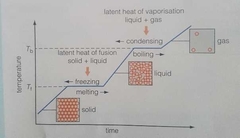![]()
![]()
![]()
Use LEFT and RIGHT arrow keys to navigate between flashcards;
Use UP and DOWN arrow keys to flip the card;
H to show hint;
A reads text to speech;
19 Cards in this Set
- Front
- Back
- 3rd side (hint)
|
What is Internal energy? |
Sum of randomly distributed kinetic energies and potential energies of the particles in a body |
|
|
|
For internal energy what is the kinetic energy of the particles dependant on? |
Temperature of the particles |
|
|
|
For the particles in the body what are the potential energies dependant on? |
Intermolecular forces between the particles |
|
|
|
What is the first law of thermodynamics? |
Increase in internal energy of a system is equal to heat added to system minus work done by the system |
U=Q-Wd |
|
|
What is an isothermal reaction? |
A reaction where the temperature is constant |
|
|
|
What is an isobaric reaction? |
A reaction where the pressure is constant |
|
|
|
What are the 2 assumptions made for the work done by an expanding gas? |
The change in volume is very small
Force moves piston at a very slow steady rate so the external force exerted on the piston is equal to the force exerted by the pressure of the gas in the cylinder |
Rate External Force Equal |
|
|
What happens when thermal energy supplied to particles? |
Internal energy of the particles increases as average kinetic energy of the particles increase causing an increase in temperature of the particles |
|
|
|
When a system is heated what kind of factors can be measured to calculate the temperature change? |
Thermodynamic, macroscopic, measurable factors |
|
|
|
What are the macroscopic factors used to calculate thermal energy applied? |
Q= amount of thermal energy applied M= mass of substance C= specific heat capacity of substance ^T= temperature change |
Bonu |
|
|
Define specific heat capacity? |
Amount of thermal energy required to increase the temperature of 1kg of material by 1 Kelvin |
|
|
|
What happens when a hot liquid or solid is placed into a cold liquid? |
Internal energy transferred from the hot object when it cools down is equal to the thermal energy gained by the liquid + container + the thermal energy lost to the surroundings |
|
|
|
What must your final answer for the resultant temperature when a hot and cold body are mixed be? |
It must be less than the temperature of the hot body whilst greater than the temperature of the cold body |
|
|
|
When there is a change of state of one/both of the bodies when mixing then what must you factor in? |
The latent heat of fusion / vaporisation for the bodies |
|
|
|
Define specific latent heat |
Amount of thermal energy required to change the state of 1kg of material without a change in temperature at a specific ambient pressure |
|
|
|
What happens during a change of state? |
Thermal energy is used to increase the internal energy of the molecules this is measured as a temperature change |
|
|
|
Why is the thermal energy called a latent heat when the state changes? |
During the change of state the temperature does not change despite to thermal energy being supplied to the substance |
|
|
|
What is the equation used to calculate the amount of thermal energy required to change the state of a substance? |
Q=ml (Lv/Lf) |
|
|

Describe this Kinetic Theory graph |
Heating of solid causes increase in internal energy of molecules up to the melting point this is measured as a temperature change
At the melting point of the solid the thermal energy supplied is used to break the intermolecular bonds between the solid particles freeing them into liquid form no temperature change is measured
In liquid form the thermal energy supplied further increases the internal energy of the molecules this increase in internal energy is measured as a temperature change
At boiling point the thermal energy supplied is then used to fully break the intermolecular bonds between the liquid particles so no temperature change is observed to the bonds are fully broken and the internal energy can increase further |
|

